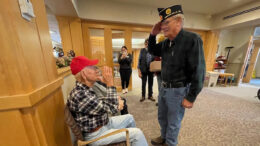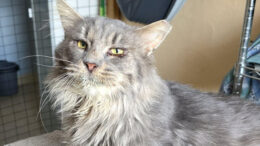PITTSBURGH (AP) – “I had one of those.”
That’s likely to be the most common phrase uttered by visitors to the new “Toys” exhibit at the Senator John Heinz History Center, predicts Brady Smith, center spokesman.
But his colleague Emily Ruby suggested an alternative: “I wanted that.”
Smith and Ruby provided an early look at the almost 500 “Toys of the ’50s, ’60s and ’70s” that go on display Friday at the history museum in Pittsburgh’s Strip District.
The items range from an American Flyer electric train and a Davy Crockett hat to Barbie dolls and GI Joe action figures. Visitors also will have opportunities to dunk Nerf balls, gyrate with hula hoops and race Slinkys down a staircase.
The “Toys” exhibit is a traveling show created by the Minnesota Historical Society. The 8,000-square-foot version at the History Center adds items devoted to playthings with links to the Pittsburgh region. Among the toys in those display cases will be pressed tin and steel items made by the Wolverine Toy Co. The firm was based for decades on what is now the city’s North Side, Ms. Ruby said. She is curator for the show’s local component, which also pays tribute to Slinky.
The steel-spring toy, made for decades in Blair County’s Hollidaysburg, was inducted in 2000 into the National Toy Hall of Fame.
Adam Scher, senior curator at the Minnesota Historical Society in St. Paul, described “Toys” as a follow-up to his museum’s “1968” exhibit. That display, which focused on artifacts tied to a pivotal year in American history, also was hosted locally by the Heinz History Center.
The new exhibit will conjure up memories for baby boomers, Scher said in a telephone interview. “They can recall playing with many of these toys – and later introducing them to their children or grandchildren.” The exhibit reflects changes in American society.
“Visitors to this exhibit will be surprised by what toys reveal about the past and the way we lived and played,” said Andrew Masich, the history center’s president. “The 1950s, ’60s and ’70s were dynamic decades. Americans and their toys changed in important ways. Playthings from that era provide a glimpse of what was happening in American society.”
Toys in the 1950s were gender-specific, Scher said. Most girls were encouraged to play with dolls, while boys played with Erector Sets, electric trains and cowboy gear.
Mattel introduced Barbie in 1959 and soon extended the product line with the fashion doll’s relatives, friends and a boyfriend. Barbie not only had an extensive wardrobe but also her own large house and cars. The design of her dwellings is reflected in design of the exhibit’s 1960s and 1970s living rooms, where many of the toys are displayed. The exhibit’s 1950s living room is based on a Louis Marx & Co. toy house.
Television commercials for toys from each decade play in 5-minute loops in each of the living rooms. “The growth of television expanded the demand for toys, both through TV advertising and an increase of toys based on popular programs,” Masich said.
Examples in the “Toys” exhibit include a Howdy Doody doll, Mickey Mouse Club items and Sesame Street playthings. When Hasbro introduced its GI Joe in 1964, it was the company’s attempt to build a competing franchise similar to Barbie but directed at males. The company hoped that boys would want not only the basic figure but also its many accessories. War weariness during the Vietnam War resulted in GI Joe changing from a soldier to a man of action.
The 1960s also saw the arrival of counter-culture toys.
While earlier model kits concentrated on military hardware, airplanes and Big Three autos, designer Ed “Big Daddy” Roth created dragster models that featured an anti-Mickey Mouse called Rat Fink.
Among the toys and games on display with links to Minnesota are the sturdy trucks and construction vehicles made by Tonka Toys and the party game Twister. The idea behind Twister, a co-ed game for two or three players, is to maintain balance while participants must place their hands and feet on different colored circles on a plastic mat. The results can lead to players being draped over one another. “It was a ground-breaking game in that it allowed players to be physically close,” Scher said.
While at least one major department store initially refused to carry it, Twister gained popularity, especially on college campuses, he said.
Two phenomena changed toys and culture in the late 1970s and early 1980s. The first was the release of the first “Star Wars” movie and its flood of film-connected merchandise. The “Toys” exhibit includes a model of the film’s Millennium Falcon and a complete set of 1977 3-inch action figures.
Some museumgoers may react with near religious fervor to the “Star Wars” items. “This could be like the (History Center’s 2010-11) Vatican exhibit,” Richard Rummel joked. “You may have visitors kneeling down in front of the ‘Star Wars’ figures.”
Rummel, project manager for the Minnesota Historical Society, is part of the team setting up the display’s Pittsburgh version.
The second major change in the industry was the arrival of computer chips in toys. Early examples in the show include Mattel’s handheld electronic football game, a favorite of Rummel’s. Other early electronic games on display include the musical memory game Simon and Speak & Spell. Items have come from museums and private collectors.
The Smithsonian Institution’s National Museum of American History has loaned two items: a 1950s-era Mr. Potato Head and a Digi-Comp 1, an early mechanical computer.
Visitors to the exhibit will have several chances to not only see toys but also play with some of them. Children and adults will be able to try about 20 vintage games, including Hungry Hippos and Rock’em Sock’em Robots. A final stop – and maybe the hardest to get away from – is a 1980s pinball and electronic game arcade.
Admission to the History Center comes with one game token and visitors can buy more tokens at four for $1. The classic arcade games include Ms. PacMan and Donkey Kong. The pinball machines and arcade games have been provided by the nonprofit Replay Foundation in Scott.
(This story was first published in the Pittsburgh Post-Gazette.)































